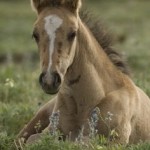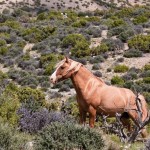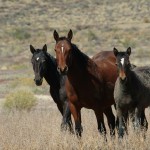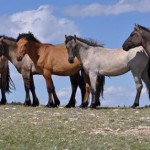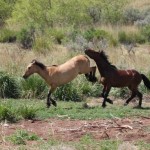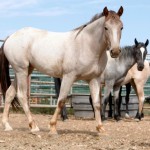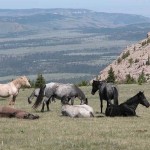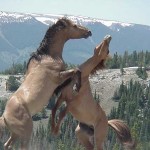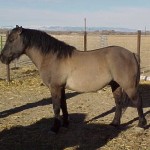Pryor Mountain Mustang
Pryor Mountain Mustang is a subtype of Mustang horses living in the Pryor Mountain Wild Horse Range that lie near Lovell, Wyoming and Billings, Montana in the US. These wild horses are preserved by the WFRHBA (Wild and Free-Roaming Horses and Burros Act) while the BLM (Bureau of Land Management) has set their optimum number at 120. Some of these free-roaming horses have also been domesticated, exhibiting remarkable features such as strength, stamina, and sure-footedness.
Pryor Mountain Mustangs Pictures
- Pryor Mountain Mustang Foal
- Pryor Mountain Mustang Horse Stud
- Pryor Mountain Mustang Horse
- Pryor Mountain Mustang Stallion
- Pryor Mountain Mustang
- Pryor Mountain Mustangs Horse Pictures
- Pryor Mountain Mustangs Horse
- Pryor Mountain Mustangs Horses
- Pryor Mountain Mustangs Pictures
- Pryor Mountain Mustangs
Quick Information
| Other Names | Pryor Mustang |
| Temperament / Personality | Intelligent, distrustful, easily scared of humans, avoid contact with people; trained or domesticated horses are calm and gentle, form strong bonds with their owner |
| Physical Characteristics | Heavy, muscular conformation with strong bones; long manes and tails, very heavy and wavy winter coat; straight or convex head, broad forehead tapering to the muzzle, hooked ears, wide-set eyes; even front teeth, long upper lips, small, crescent-shaped nostrils; medium-sized neck, long and sloping shoulders, prominent withers, medium to narrow chest; inclined croup, large and hard hooves |
| Colors | Solid colors, such as black, bay, dun, grullo, chestnut, red or blue roan; pinto and buckskin patterns are rare; dun horses have horizontal stripes on the forelegs, transverse and dorsal stripes on the withers |
| Common Use | General riding or any other task performed by domesticated breeds, but require training |
| Height (size) | Average of 14-14.2 hands (142-147 cm, 56-58 inches); some may have a smaller or larger conformation |
| Weight | 320-360 kg (700-800 lbs) |
| Health | Healthy horses with no known breed-specific issues |
| Gaits | Well-balanced, natural ambling movements |
| Popular Traits | Compactness, short and sturdy conformation, very hardy, high endurance |
| Feeding/Diet | Grass, hay, leaves and flowers of plants and weeds; frequently lick the soil that tastes slightly salty ingesting nutrients such as sodium, calcium, magnesium, and potassium; sufficient amounts of water |
| Originated in | North America |
| Ancestors | Spanish Barb horses, Irish Hobby, Canadian, American Saddlebred, Tennessee Walking, Thoroughbred, and Arabian horses |
| Year/Time of Development | Late 1600s to early 1700s |
Pryor Mountain Mustang Video
History and Development
It is believed that the herds of wild horses have lived in the Pryor Mountain range since the late 17th century. Historical references of Native American tribesmen indicate that these horses were brought to the place during the 1720s. Hundreds of wild horses were possessed by the natives and the tribal people in the mid-18th century. By the time the Pryor Mountains were inhabited by the pioneer settlers, the population of feral horses was more than a thousand.
Up until the 1930s, domesticated stallions were added to the herd and allowed to breed with the mares producing specialized cavalry horses that served the military. In 1934, the Taylor Grazing Act was approved allowing cattle to graze in the Pryor Mountain region. During the 1940s, the population of these horses was not protected by law. The loose and unbranded horses were often assembled and were either used for riding or sold to slaughter. However, the Wild Horse Annie Act prohibited the use of automobiles and motor vehicles to chase and capture wild horses.
In 1964, the BLM declared that it would remove all the Pryor Mountain wild horses and disperse them through auctions, an initiative that spurred widespread public opposition. This temporarily delayed the movement against these horses. By 1968, these animals were mostly limited to the BLM lands due to the construction of fences and earlier roundups. In the same year, the BLM again concentrated on removing the herd, but with a possibility of returning 15-35 horses to the range. Concerned with the fate of these animals, the PMWHA (Pryor Mountain Wild Horse Association) was established. It worked with other organizations including the ISPA to prevent the roundup.
The tussle around the Pryor Mountain horses continued until the enactment of the WFRHBA in 1971. This Act prevented killing or harassing of wild burros and horses on federal land, needed the Agriculture and Interior departments to protect these animals, encouraged studies of their habits and habitats, as well as authorized public land for their use. The Act was jointly administered by the US Forest Service and the BLM.
Interesting Facts
- As revealed by genetic studies, the herd of Pryor Mustangs exhibits a great degree of diversity in its genetic characteristics.
- A documentary movie called “Cloud: Wild Stallion of the Rockies” as well as its sequel named “Cloud’s Legacy: The Wild Stallion Returns” is based on the Pryor Mountain Mustang herd.


